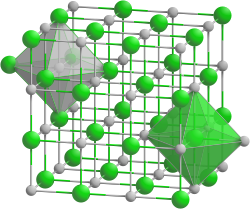Lead (II) sulfide
| Crystal structure | ||||||||||||||||
|---|---|---|---|---|---|---|---|---|---|---|---|---|---|---|---|---|

|
||||||||||||||||
| __ Pb 2+ __ S 2− | ||||||||||||||||
| Crystal system |
cubic |
|||||||||||||||
| Space group |
Fm 3 m (No. 225) |
|||||||||||||||
| Coordination numbers |
Pb [6], S [6] |
|||||||||||||||
| General | ||||||||||||||||
| Surname | Lead (II) sulfide | |||||||||||||||
| other names |
Lead sulfide |
|||||||||||||||
| Ratio formula | PbS | |||||||||||||||
| Brief description |
black, odorless solid |
|||||||||||||||
| External identifiers / databases | ||||||||||||||||
|
||||||||||||||||
| properties | ||||||||||||||||
| Molar mass | 239.27 g mol −1 | |||||||||||||||
| Physical state |
firmly |
|||||||||||||||
| density |
7.5 g cm −3 |
|||||||||||||||
| Melting point |
1114 ° C |
|||||||||||||||
| solubility |
|
|||||||||||||||
| safety instructions | ||||||||||||||||
|
||||||||||||||||
| As far as possible and customary, SI units are used. Unless otherwise noted, the data given apply to standard conditions . | ||||||||||||||||
Lead (II) sulfide is a chemical compound made up of the elements lead and sulfur . It is a salt with the ratio formula PbS.
Occurrence
Lead (II) sulfide occurs naturally in large quantities in the form of the mineral galena ( galena ).
Extraction and presentation
Lead (II) sulfide can be prepared by introducing hydrogen sulfide or addition of a sodium sulphide - solution be prepared in a salt solution of lead.
While only pure amorphous or partially crystallized lead (II) sulfide precipitates are obtained in the precipitation of lead salt solutions, a uniformly crystallized lead (II) sulfide of approximately more uniformity can be obtained by reacting sodium tetrahydroxoplumbate (II) solution with thiourea Represent crystal size.
properties
Lead (II) sulfide forms large, lead-gray, metal-shining crystals that can be easily split. The lattice structure corresponds to that of sodium chloride .
The compound is sparingly soluble in water, as well as in cold dilute hydrochloric acid and sulfuric acid . By introducing hydrogen sulfide into a lead (II) salt solution , a black precipitate of PbS is formed due to the excess of the solubility product :
- Dissolved lead ions combine with sulfide (S 2− ) to form poorly soluble lead (II) sulfide.
With this sensitive reaction, very small traces of lead can be detected in the water . In contrast, lead (II) sulfide is easily soluble in nitric acid . In concentrated hydrochloric acid it decomposes with the evolution of hydrogen sulfide:
- Lead (II) sulfide reacts with concentrated hydrochloric acid to form lead (II) chloride and hydrogen sulfide.
Lead (II) sulfide melts at 1114 ° C .
When heated in the air ( roasting ), the compound finally burns independently to form lead (II) oxide :
- Lead (II) sulfide reacts with oxygen in the air to form lead (II) oxide, lead (II) sulfate and sulfur dioxide .
use
Lead sulfide is a semiconductor and is used as a detector material for infrared receivers (e.g. in telescopes ). It is also used as a vulcanization accelerator in the rubber industry and as a raw material in the glass and ceramic industry. It also serves as an aid for emitting special frequency bands in flares .
Individual evidence
- ↑ a b c d e Entry on lead (II) sulphide in the GESTIS substance database of the IFA , accessed on January 8, 2020(JavaScript required) .
- ↑ a b Entry on lead sulfide. In: Römpp Online . Georg Thieme Verlag, accessed December 10, 2014.
- ↑ Not explicitly listed in Regulation (EC) No. 1272/2008 (CLP) , but with the specified labeling it falls under the group entry lead compounds with the exception of those named in this annex in the Classification and Labeling Inventory of the European Chemicals Agency (ECHA), accessed on December 14, 2016. Manufacturers or distributors can expand the harmonized classification and labeling .
- ↑ Georg Brauer (Ed.), With the collaboration of Marianne Baudler a . a .: Handbook of Preparative Inorganic Chemistry. 3rd, revised edition. Volume I, Ferdinand Enke, Stuttgart 1975, ISBN 3-432-02328-6 , p. 778.







